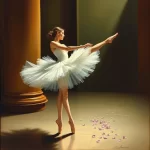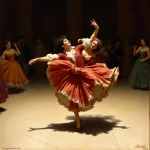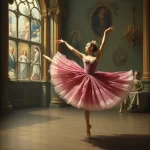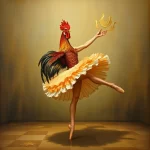Ballet: La Valse (Maurice Ravel, 1920)

Introduction
Ballet: La Valse is a one-act ballet composed by Maurice Ravel in 1920. The ballet was choreographed by Bronislava Nijinska and premiered on December 12, 1928, at the Opéra Garnier in Paris. La Valse is a vivid and dramatic portrayal of the waltz, capturing its elegance and underlying tension. The ballet explores themes of decadence, the passage of time, and the inevitable decline of an era.
Historical Background
Creation and Development
La Valse was created in the aftermath of World War I, a period marked by significant social, political, and artistic upheaval. The war had a profound impact on European society, leading to a sense of disillusionment and a questioning of traditional values. This context influenced Ravel’s composition, which can be seen as a reflection on the fragility of beauty and the inevitability of decay.
Ravel was inspired by the Viennese waltz, a dance form that had reached its peak in the 19th century. He sought to capture both its elegance and its darker, more sinister undertones. The collaboration between Ravel and Nijinska was crucial in bringing this vision to life. Nijinska’s choreography complemented Ravel’s music, emphasizing the tension and drama inherent in the waltz.
Premiere and Reception
La Valse premiered on December 12, 1928, at the Opéra Garnier in Paris. The initial reception was mixed, with some critics praising the ballet’s innovative approach and others finding it too avant-garde. Despite this, the ballet quickly gained popularity and became a staple in the repertoires of major ballet companies. Notable early performances included those by the Ballets Russes and the Paris Opera Ballet.
Synopsis of the Ballet
La Valse is a one-act ballet that unfolds in a single continuous movement. The ballet begins with a mysterious and foreboding introduction, setting the stage for the drama to come. As the music progresses, the waltz theme emerges, and the dancers take to the stage in a series of elegant and intricate patterns.
The ballet’s key moments include a series of duets and group dances that highlight the tension between beauty and decay. The climax of the ballet occurs as the music becomes increasingly frenetic, and the dancers’ movements become more chaotic. The ballet concludes with a dramatic and unsettling finale, leaving the audience with a sense of unease and reflection.
Musical Composition
Composer’s Role
Maurice Ravel was a prominent French composer known for his innovative and evocative compositions. In La Valse, Ravel’s music plays a central role in conveying the ballet’s themes and emotions. The score is characterized by its lush orchestration, complex rhythms, and dramatic contrasts. Notable pieces within the score include the haunting introduction, the sweeping waltz theme, and the frenetic finale.
Musical Themes and Motifs
La Valse features several recurring musical themes and motifs that enhance the narrative and emotional impact of the ballet. The waltz theme, with its elegant and flowing melody, represents the beauty and grace of the dance. However, this theme is often interrupted by dissonant and jarring passages, reflecting the underlying tension and decay. The music’s dynamic shifts and contrasts mirror the dancers’ movements, creating a powerful and immersive experience.
Famous Recordings and Performances
There have been numerous iconic recordings and performances of La Valse‘s music. Notable recordings include those by the Boston Symphony Orchestra conducted by Seiji Ozawa and the London Symphony Orchestra conducted by André Previn. These recordings capture the richness and complexity of Ravel’s score, bringing the ballet’s dramatic narrative to life.
Choreography and Dance
Choreographer’s Vision
Bronislava Nijinska’s choreography for La Valse is characterized by its innovative and expressive style. Nijinska sought to capture the elegance and tension of the waltz through intricate and dynamic movements. Her choreography emphasizes the contrast between the dancers’ graceful patterns and the underlying sense of unease, creating a powerful and evocative performance.
Signature Dance Numbers
Key dances in La Valse include the opening group waltz, which sets the stage for the ballet’s drama, and the series of duets that highlight the tension between the dancers. The climax of the ballet features a frenetic and chaotic dance, reflecting the music’s increasing intensity. These signature dance numbers are integral to the ballet’s narrative and emotional impact.
Notable Interpretations
Over the years, different productions of La Valse have interpreted Nijinska’s choreography in various ways. Some productions have emphasized the ballet’s elegance and beauty, while others have focused on its darker and more unsettling aspects. Notable interpretations include those by the Ballets Russes, the Paris Opera Ballet, and contemporary companies such as the New York City Ballet.
Characters and Roles
Main Characters
La Valse does not have specific named characters, but rather features a series of dancers who represent different aspects of the waltz. The lead dancers often take on the roles of the central couple, whose relationship reflects the ballet’s themes of beauty and decay.
Supporting Characters
The supporting dancers in La Valse play a crucial role in creating the ballet’s intricate patterns and dynamic movements. They represent the larger social context of the waltz, contributing to the ballet’s overall atmosphere and drama.
Famous Dancers
Notable dancers who have performed in La Valse include Serge Lifar, who was a principal dancer with the Ballets Russes, and more recently, dancers such as Wendy Whelan and Damian Woetzel of the New York City Ballet. These performers have brought their own unique interpretations to the ballet, contributing to its enduring legacy.
Cultural and Artistic Impact
Influence on Ballet and Dance
La Valse has had a significant influence on the world of ballet and dance. Its innovative choreography and evocative music have inspired other choreographers and composers, contributing to the development of ballet as an art form. The ballet’s exploration of themes such as beauty, decay, and the passage of time has resonated with audiences and artists alike.
Cultural Significance
La Valse holds a prominent place in popular culture and has been referenced in literature, film, and other media. Its themes of decadence and decline have made it a powerful symbol of the fragility of beauty and the inevitability of change. The ballet has also been adapted in various forms, including film and theater productions.
Legacy and Revivals
La Valse continues to be performed and celebrated today, with major ballet companies around the world including it in their repertoires. The ballet has been revived and reinterpreted by contemporary choreographers, ensuring its relevance and appeal to modern audiences. Its enduring legacy is a testament to its artistic and cultural significance.
Iconic Productions
Historic Productions
Some of the most famous historical productions of La Valse include those by the Ballets Russes, which premiered the ballet in 1928, and the Paris Opera Ballet. These productions featured notable figures such as Serge Lifar and Bronislava Nijinska, who played key roles in bringing the ballet to life.
Contemporary Productions
Recent productions of La Valse have continued to explore and reinterpret the ballet’s themes and choreography. Companies such as the New York City Ballet and the Royal Ballet have staged contemporary versions of the ballet, incorporating modern elements while staying true to its original vision. These productions highlight the ballet’s enduring appeal and relevance.
Production Design
The set, costume, and lighting design in various productions of La Valse have played a crucial role in creating the ballet’s atmosphere and drama. Historic productions often featured opulent and elaborate designs, reflecting the elegance of the waltz. Contemporary productions have experimented with more minimalist and abstract designs, emphasizing the ballet’s underlying tension and decay.
Critical Reception and Reviews
Initial Critical Response
The initial critical response to La Valse was mixed, with some critics praising its innovative approach and others finding it too avant-garde. Despite this, the ballet quickly gained popularity and became a staple in the repertoires of major ballet companies. Its unique combination of music and choreography was recognized as a significant contribution to the world of ballet.
Modern Reviews
Contemporary critics and audiences continue to appreciate La Valse for its artistic and emotional depth. The ballet is often praised for its innovative choreography, evocative music, and powerful themes. Its exploration of beauty, decay, and the passage of time remains relevant and resonant, ensuring its enduring popularity.
Fun Facts and Trivia
Behind-the-Scenes Stories
One interesting anecdote from the production of La Valse involves Ravel’s initial reluctance to compose a ballet based on the waltz. He was eventually persuaded by Sergei Diaghilev, the founder of the Ballets Russes, who recognized the potential of Ravel’s music to create a powerful and evocative ballet.
Notable Performers
Famous dancers associated with La Valse include Serge Lifar, who was a principal dancer with the Ballets Russes, and more recently, dancers such as Wendy Whelan and Damian Woetzel of the New York City Ballet. These performers have brought their own unique interpretations to the ballet, contributing to its enduring legacy.
Trivia
- La Valse was originally conceived as a purely orchestral work before being adapted into a ballet.
- The ballet’s premiere was delayed due to the outbreak of World War I, and it was not performed until 1928.
- Ravel described La Valse as a “choreographic poem,” emphasizing its narrative and emotional depth.
Conclusion
Summary of the Ballet’s Importance
La Valse is a significant work in the world of ballet, known for its innovative choreography, evocative music, and powerful themes. The collaboration between Maurice Ravel and Bronislava Nijinska resulted in a ballet that captures the elegance and tension of the waltz, exploring themes of beauty, decay, and the passage of time.
Final Thoughts
La Valse remains a relevant and resonant work, continuing to be performed and celebrated by major ballet companies around the world. Its enduring appeal is a testament to its artistic and cultural significance. For those who have not yet experienced La Valse, it is highly recommended to watch a performance or listen to the score to appreciate its depth and beauty.
FAQ
What is the central theme of this ballet?
The central theme of La Valse is the tension between beauty and decay, exploring the fragility of elegance and the inevitability of decline.
Who are the main characters in this ballet?
La Valse does not have specific named characters but features a series of dancers who represent different aspects of the waltz.
What is the most famous dance number in this ballet?
The most famous dance number in La Valse is the frenetic and chaotic climax, which reflects the music’s increasing intensity and the ballet’s dramatic narrative.
How long does a typical performance of this ballet last?
A typical performance of La Valse lasts approximately 12-15 minutes, as it is a one-act ballet.
Are there any modern adaptations of this ballet?
Yes, there have been numerous modern adaptations of La Valse, with contemporary choreographers and ballet companies reinterpreting its themes and choreography.
Why is this ballet considered important in the history of dance?
La Valse is considered important in the history of dance due to its innovative choreography, evocative music, and exploration of powerful themes. It has had a significant influence on other works and continues to be celebrated and performed today.





